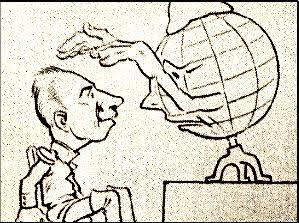O Kaiser (lost Brazilian first animated film; 1917): Difference between revisions
No edit summary |
No edit summary |
||
| Line 1: | Line 1: | ||
{{NeedingWork|lack of content}} | {{NeedingWork|lack of content}} | ||
{{ | {{InfoboxLost | ||
|title=Kaiser | |title=<center>Kaiser</center> | ||
|image=Kaiser short film frame.jpeg | |image=Kaiser short film frame.jpeg | ||
|imagecaption=The only surviving frame of the film | |imagecaption=The only surviving frame of the film. | ||
|status= | |status=<span style="color:red;">'''Lost'''</span> | ||
}} | }} | ||
'''''Kaiser''''' was a Brazilian animated short film, considered to be the first Brazilian animation. Produced by businessman and politician Sampaio Corrêa, the film was, in fact, an animated cartoon by cartoonist Seth, pseudonym of Álvaro Marins. A critique of the German expansionism amid the tensions of World War I, the film showed Emperor William II sitting in front of a terrestrial globe and then putting his military helmet on | '''''Kaiser''''' was a Brazilian animated short film, considered to be the first Brazilian animation. Produced by businessman and politician Sampaio Corrêa, the film was, in fact, an animated cartoon by cartoonist Seth, pseudonym of Álvaro Marins.<ref>[https://oglobo.globo.com/cultura/filmes/primeiro-desenho-animado-do-pais-kaiser-completa-100-anos-20808056 O Globo article about ''Kaiser'''s 100th anniversary.] Retrieved 11 Jul '21</ref> A critique of the German expansionism amid the tensions of World War I, the film showed Emperor William II sitting in front of a terrestrial globe and then putting his military helmet on "the head of the globe," representing that he "controls the world." However, the object comes to life and ends up swallowing the sovereign. | ||
In Brazil, very short animations have been produced since 1908. However, ''Kaiser'' is considered the first true Brazilian animation because it was "conceived in a complete and systematic way, based on a narrative with a beginning, middle and end" | In Brazil, very short animations have been produced since 1908. However, ''Kaiser'' is considered the first true Brazilian animation because it was "conceived in a complete and systematic way, based on a narrative with a beginning, middle and end," and because it used a "complex technique." | ||
''Kaiser'' premiered on January | ''Kaiser'' premiered on January 22nd, 1917, at Cine Pathé. The film has since been considered lost forever, with only one frame of it surviving. In 2013, the documentary ''Luz, Anima, Ação'' (''Light, Animate, Action''), by Eduardo Calvet, recreated ''Kaiser'', with the collaboration of eight animators. | ||
== References == | ==References== | ||
{{reflist}} | |||
[[Category:Lost animation]] | |||
[[Category:Lost films]] | |||
[[Category:Historic]] | |||
Revision as of 01:48, 14 July 2021
Kaiser was a Brazilian animated short film, considered to be the first Brazilian animation. Produced by businessman and politician Sampaio Corrêa, the film was, in fact, an animated cartoon by cartoonist Seth, pseudonym of Álvaro Marins.[1] A critique of the German expansionism amid the tensions of World War I, the film showed Emperor William II sitting in front of a terrestrial globe and then putting his military helmet on "the head of the globe," representing that he "controls the world." However, the object comes to life and ends up swallowing the sovereign.
In Brazil, very short animations have been produced since 1908. However, Kaiser is considered the first true Brazilian animation because it was "conceived in a complete and systematic way, based on a narrative with a beginning, middle and end," and because it used a "complex technique."
Kaiser premiered on January 22nd, 1917, at Cine Pathé. The film has since been considered lost forever, with only one frame of it surviving. In 2013, the documentary Luz, Anima, Ação (Light, Animate, Action), by Eduardo Calvet, recreated Kaiser, with the collaboration of eight animators.
References
- ↑ O Globo article about Kaiser's 100th anniversary. Retrieved 11 Jul '21

